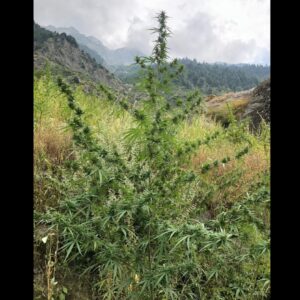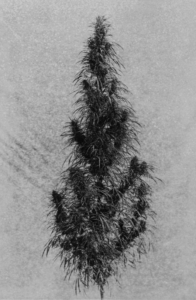Short answer – no, a landrace is a type of domesticate. In other words, landraces are created by humans. In that sense, landraces are exactly the opposite of ‘wild’ or ‘natural’.
In fact, even in areas of the world where drug-type cannabis does grow naturally, such as the Himalaya or Punjab, these wild-growing stands of wild-type cannabis provide only a tiny fraction of the harvest of cannabis ‘drugs’.
Wild-type plants account for a miniscule proportion of what tokers consume in traditional cannabis cultivating regions such as Afghanistan and Nepal, and absolutely none whatsoever in tropical regions like Thailand and Laos.

Wild-type cannabis growing wild in northern Pakistan, formally var. himalayensis. Photo by Landrace Genetics.
Shown above is wild-type cannabis in northern Pakistan. This is not a landrace. This is a wild-type plant. Formally, this can be classified as Cannabis sativa subsp. indica var. himalayensis. Only a tiny fraction of the charas harvest comes from such plants. None of the ganja harvest does.
To clarify the contrast with wild-type cannabis, a literal translation of the German term ‘Landrasse’ is not ‘landrace’ but ‘country-breed’. Cannabis landraces are traditional domesticates – plant breeds with a long history of conscious and unconscious selection for specific products, principally ganja in South Asia and charas in Central Asia.
One very easy way to determine that a cannabis plant is not a landrace is by the way seeds are very small and drop from the inflorescence (‘shattering’). This is an adaptive trait for wild conditions. Seeds of landraces are much larger and remain within the inflorescence until harvest. Other wild-type traits are elongated bases of seeds, low cannabinoid and essential oil levels, and small leaves – i.e., small leaf area. In a classical taxonomic key like McPartland and Small’s, wild-type plants get classified as distinct formal varieties such as var. himalayensis or var. asperrima – i.e., distinct from landraces.
If they’re harvested at all in traditional Asian cannabis cultures, wild-growing populations of wild-type plants are mostly harvested for the most basic cannabis product, namely bhang. That’s bhang in the sense of leaf and coarse, seeded inflorescence. Bhang is consumed in food and drink such as pakoras and thandai. Harvesting wild-growing cannabis is fairly common practice, particularly north of the Ganges in northern India and in eastern Pakistan – i.e, the Punjab.

Bhang, the most basic cannabis ‘drug’ product, which is sometimes prepared from wild-type stands in regions such as Punjab.
Occasionally, high-altitude wild-growing populations in the Himalaya are hand-rubbed for charas. But this makes a cheaper, lower grade product than the charas from actual landraces. ‘Jungli’ charas should sell at a fraction of the price of the charas from cultivated fields of landraces.
Another name for bhang is ‘siddhi’.
As the Indian Hemp Drugs Commission puts it:
While siddhi is obtained indifferently from [cannabis], whether cultivated or wild,
and, it is said, whether female or male, charas, we have seen is, as a rule, obtained
chiefly, though not entirely, from cultivated plants, and only from female ones;
nothing, however, is done, even when they are cultivated, to prevent the charas
plants from running their natural course. Gánjá is obtained from cultivated
plants only and of the female sex exclusively, the males being not only not used,
but not permitted to grow in the vicinity of the crop, in order that the formation
of seeds may be as far as possible prevented.
Some wandering yogis (‘sadhus’) harvest wild-type bud to smoke, but this is not real ganja. Mostly I’ve heard this called ‘patti’ (i.e., bhang). Seeded and way less potent or aromatic than real ganja, patti is literally a poor man’s smoke, something that I’ve only ever seen among sadhus / fakirs. Usually sadhus collect patti while wandering in the Himalaya. One reason for this is the high altitude makes for bud with nicer aromas and higher resin content than that of wild-growing lowland stands. Another reason is that stands of cannabis near urban centres or roads accumulate large amounts of dust and are very unhygienic.
By contrast to bhang, patti, or ‘jungli’ charas, 1970s UK government seizure figures show ‘Thai Stick’ ganja from Isan and Lao landraces with up to 17% THC, along with charas and hash oils from the Hindu Kush at up to c. 40% THC. That’s the difference between wild-type and landrace cannabis.

‘Map of India showing the area where the hemp plant grows wild, and where it might run wild under favourable circumstances’ – Indian Hemp Drugs Commission, 1894
South of the Ganges River in India there is next to no wild-growing cannabis except at altitude. There is little in desert Central Asia either, except along rivers and feral around homes. There is next to none in tropical Southeast Asia.
The two high-end traditional cannabis drug products are ganja (sinsemilla) and charas (resin). With rare exceptions in the case of charas, they are produced from landraces. These landraces are specific to the products.
Shown below is a Bengali ganja landrace, formally Cannabis sativa subsp. indica var. indica. Note how the plant lacks ‘fan leaves’. In traditional ganja farming, the point during senescence at which these large leaves drop off is used as an indicator that the plant is nearly ready for harvest. In 1785, Jean-Baptiste Lamarck analyzed a specimen of East Indian ganja, probably collected south from Bengal on the Coromandel Coast at Pondicherry. He noted the ganja’s strong odour “resembling somewhat that of tobacco” and intoxicating effect: “The principal effect of this plant consists of going to the head, disrupting the brain, where it produces a sort of drunkenness that makes one forget one’s sorrows, and produces a strong gaiety.”
By the late 18th Century, much of the East Indies ganja trade was already under the control of a violent and dangerously powerful multinational corporation, the East India Company, which operated out of Calcutta and London and profited aggressively from Indians’ taste for cannabis while ruling India. A century on, the Indian Hemp Drugs Commission contains photographs of the ganja fields of Bengal, which are anything but ‘wild’. Tax farmed for every last ounce of revenue, the Ganja Mahal of Bengal was now a focus of the masters of the Raj mainly because these British imperialists were seeking to improve cultivation techniques to raise crop yields, as well as working to suppress smuggling.

‘Ganja plant almost ready to cut, Naogaon. 16th February 1894.’ Indian Hemp Drugs Commission, 1894
Ignore misinformation about how cannabis landraces are ‘wild-populated’ varieties. This is simply wrong. This persistent false claim that landraces are in some literal sense wild strains also erases Asian and other farming communities and their traditions, some of which date back hundreds to thousands of years in the case of Asia. In all fairness, along with the ongoing silliness of seed-sellers crowbarring traditional cannabis cultures and plants out of their real context and into a modern seedbank / dispensary format, this is not just misinformation but itself a form of cultural colonialism, imposing western misconceptions onto the Oriental other.






